During my brief visit to Seattle the weather was most uncooperative. Today it was rain and hail, intermixed with sun. Two days earlier it was thunder, lightening, and downpours. So, I wasn’t as productive as I would have liked. Still, I managed to clean some more parts, order some parts, and work on the gas tank.
Not surprisingly, there seems to be no aftermarket replacement tank for the DJ-3A. I’m pretty sure a DJ-5 or rear CJ-5 tank would fit just fine, but I didn’t have one readily available and, besides, I was trying to stay with the DJ-3A tank. After some searching, I found one with all the parts, but it was a bit dented.
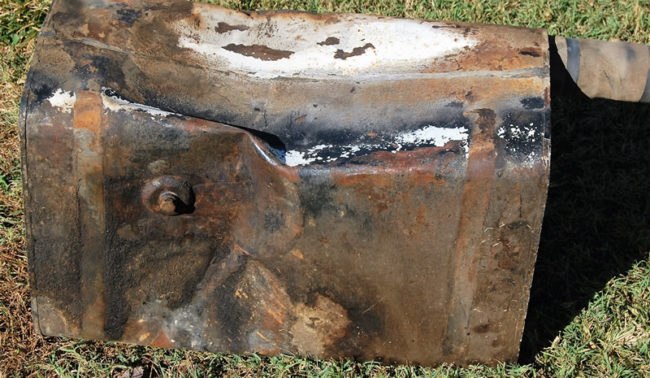
This tank took a pretty good hit.
Today I decided to get the dents out. With nothing to lose, I started by drilling an access hole in the good side so I could pound out the worst side.
My tool of choice was a 20 pound pry bar that had a round surface at the top. So, I inserted the bar upside down into the newly drilled hold and began working out the dents. It worked surprisingly well.
I also had a small sledge and a smaller bar with a rounded end that helped remove some dents.
As you can see, there is some semblance of a rectangular tank now. It’s hardly perfect, but it will do for the time being.
These strange are original DJ-3A tank straps that hold the tank under the body in the rear. I plan to keep these straps, but will replicate some heavier duty versions.

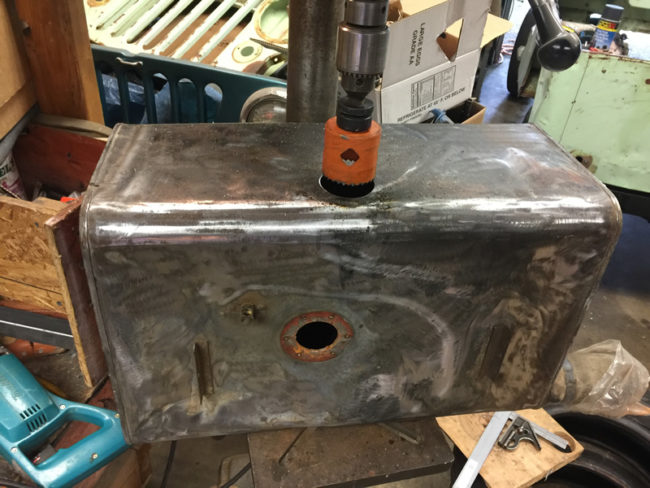
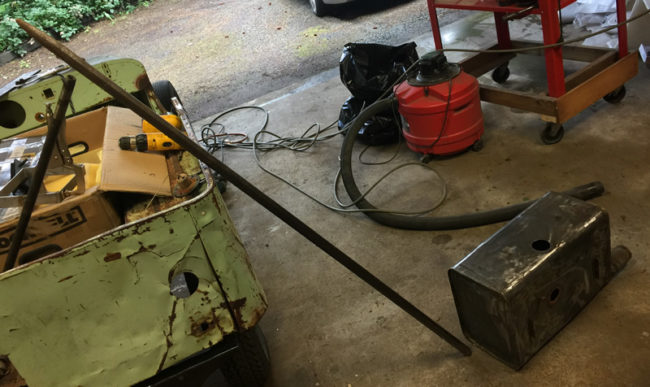
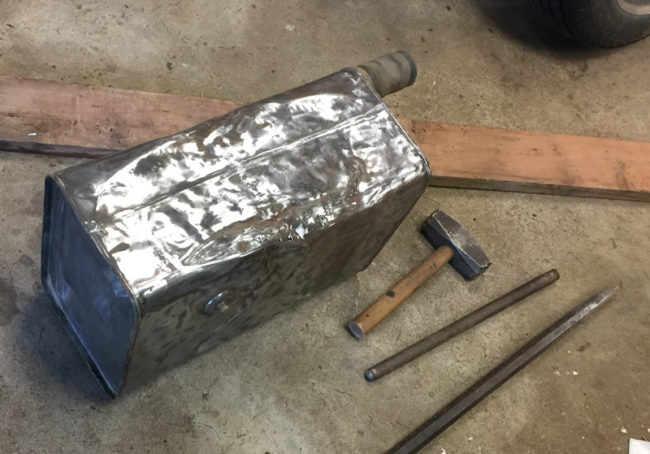
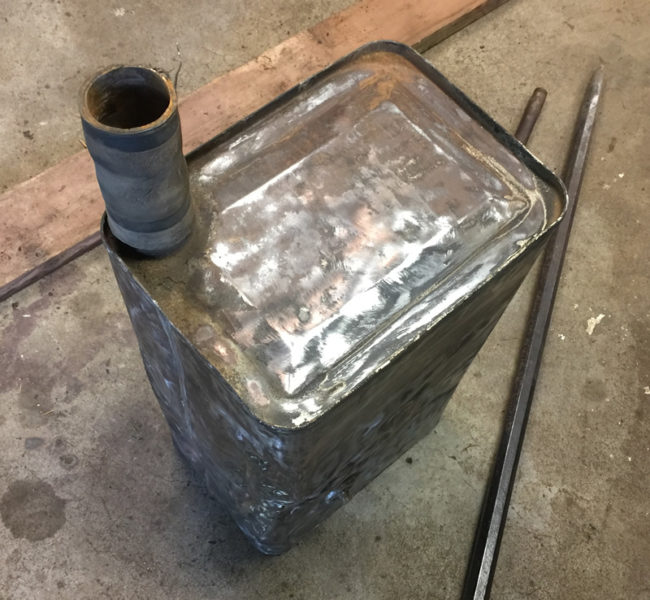
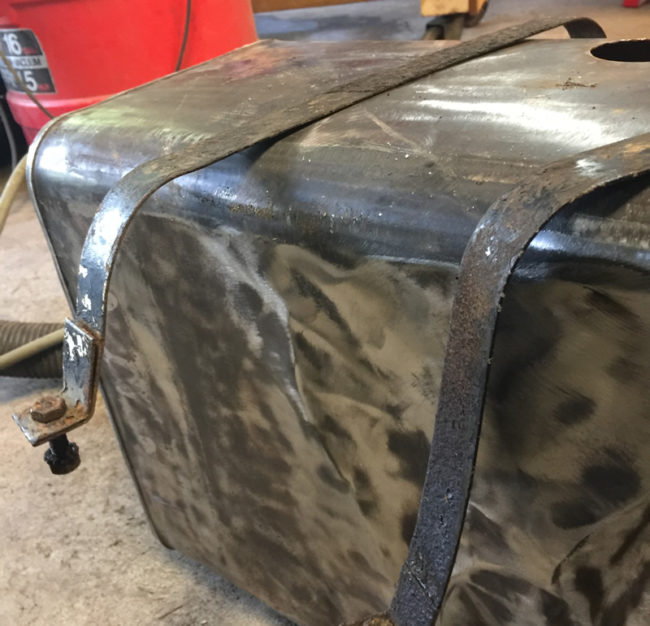
Amazing how many parts from a DJ can be used to up date a cj, I’m also using the fuel tank on a CJ-5,the brakes and steering box{left hand steer}and many small parts,enjoy your build.Jim
Thanks for sharing, Dave. It must be satisfying to bring that gas tank back to life. How will you seal the access hole you drilled out?
Steve … Duct tape? lol
I’ll have someone more skilled than I weld it. Then I’ll add a sealer, maybe something like this https://www.amazon.com/POR-15-Fuel-Tank-Sealer-Halfpint/dp/B001NGB57M .
– Dave
Dave,
Do your research on that tank sealer before you use it, even if it is By POR. I haven’t heard of one person with s positive long term (+10 years) with any tank sealer. The long term problems are far worse than the cure. I have a Jaguar Mark IX that someone used sealer on. It wasn’t pretty.
The sealers work great at first then seem to slowly break down. First symotom is either poor acceleration or intermittent stumbling. By the time you experience this (years down the road), little bits and pieces of sealer have crudded up the fuel lines, carb bowl, float needle, jets, etc. and it is one pain to get it all out.
IMO, much better to find all the leaks by doing an air pressure test with the tank submerged in water.
Hi John,
Thanks for that feedback John. I have no experience with tank sealers, but was aware that other folks were using them.
I saw that the sealer was rated highly (most were on Amazon), but that doesn’t necessarily suggest they won’t have problems long term. I’d prefer not to add the sealer (just another item to add to the budget).
Thanks,
– Dave
Dave,
I would add another voice to the no sealer comments. I have played with quite a few old tractors in the past 20 years and there is lots of discussion in that community about sealers. To me the sealers are really not used to “seal” any small leaks, the sealer is used to coat the insides of the tank to prevent corrosion. Ethanol blend fuels have added to the problem over the past years as it adds to moisture trapping inside the tank. As John has mentioned, the sealers over time tend to break down and begin to cause big issues with the fuel system. On my stuff, I have the gas tanks “hot tank” cleaned by a radiator shop and then repaired if needed. After repair and cleaning, keep tank full over any long term storage to prevent rust build up…….and stay away from ethanol blends.
Allan
Dave, here’s a cheap tip that will prevent problems when pressure testing your fuel tank. Use the fuel line connection to deliver air to the tank (one to two psi) but install a light weight latex glove over the fuel filler neck before pressurizing the tank. If you inadvertently use too high of an air pressure the glove will pop, allowing the air to safely flow thru the tank without deforming the metal. With the tank safely pressurized fill a spray bottle with bubble solution (I bought Super Miracle Bubbles at Walmart) and spray the seams of the tank. I used to use dish soap to check for leaks but the bubble solution clings to the metal better than dish soap and quickly indicates leaks by colorful bubbles forming at the leaks.
Good idea Paul. Thanks!